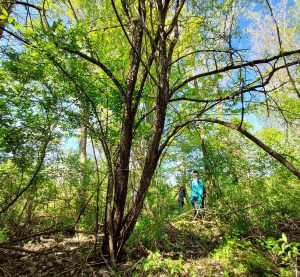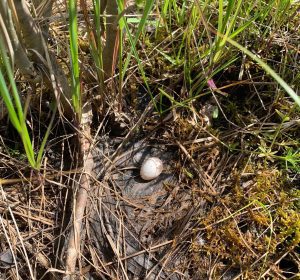By Melanie Donofrio, Invasive Species Management Assistant
Ten thousand years ago, Oak Orchard Wildlife Management Area (WMA) was submerged under glacial Lake Tonawanda. If you take NYS Route 77 to Oak Orchard, the ridge you follow is composed of glacial debris, known as a moraine, left behind by a receding iceberg that helped create the Great Lakes. Located between the Niagara Escarpment (crucial to the formation of Niagara Falls) and the Onondaga Escarpment, Oak Orchard sits in a basin with poor drainage—the geologic attribute that created the swampy wetland known as the Alabama and Tonawanda Swamps. The path of a prehistoric glacier became the road between these interconnected times and places, the same road the WNY PRISM Crew took to Oak Orchard in May of 2022.
The Crew trekked through dense forest, surveying the first site of the season. They found some key invasive species at the WMA—autumn olive, honeysuckle and common buckthorn. The 2,500-acre Oak Orchard is part of an approximately 19,000-acre complex of state and federal land that also includes Iroquois National Wildlife Refuge (NWR) and Tonawanda WMA. This small section of forest is almost completely shaded by a canopy of invasive species, including some very old buckthorn.

William, Invasive Species Management Assistant, cutting honeysuckle.
The DEC led the way with chainsaws and brush cutters, while the Crew followed behind with loppers and herbicide. Upon felling the “mother” buckthorn, 35 rings were counted in the stump. That means the buckthorn infestation in this part of Oak Orchard might have begun in the late 1980s. Since then, buckthorn and honeysuckle have monopolized the resources native species need to thrive. Although the smell of honeysuckle is intoxicating, local fauna do not recognize it as a food source, and it is not a host plant for native butterflies and moths. If fauna do eat the fruit of shrubs like honeysuckle, buckthorn or autumn olive, they do not get the nutrition they would normally receive from native species. Invasive shrubs can even cause a decline in the health of those consuming them.

The aptly named “mother buckthorn” of Oak Orchard, removed shortly after.
After four days of cutting, the landscape was transformed from an almost impenetrable forest of invasive shrubs to a more open section of land with small dogwoods, ash and ferns. Adjacent to the forest site is an additional 2.43-acre field previously cleared by the DEC. Using foliar treatment, the Crew treated the smaller versions of the woody species seen in the forest. The idea is that the field can soon be “let go” so reforestation can occur naturally. The cumulative effect of the Crew’s efforts spent at Oak Orchard will hopefully give native plants a head start in the race against invasives, creating a ripple that might radiate outwards in the years to come.

An egg found by Douglas, Field Operations Manager.


